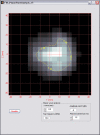Measurement of the spectral directivity of optoacoustic and ultrasonic transducers with a laser ultrasonic source
- PMID: 19791945
- PMCID: PMC2766411
- DOI: 10.1063/1.3227836
Measurement of the spectral directivity of optoacoustic and ultrasonic transducers with a laser ultrasonic source
Abstract
Comprehensive characterization of wideband ultrasonic transducers and specifically optoacoustic detectors is achieved through the analysis of their frequency response as a function of the incident angle. The tests are performed under well-defined, repeatable operating conditions. Backillumination of a blackened, acoustically matched planar surface with a short laser pulse creates an acoustic impulse which is used as a wideband ultrasonic source. Upon illumination with a short laser pulse, the bandwidth of our source shows a -6 dB point of 12 MHz and a low-frequency roll-off around 300 kHz. Using proprietary software, we examine thoroughly the planarity of the emitted wave front within a specified amplitude cutoff and phase incoherence. Analysis of the angular dependence of the frequency response yields invaluable directivity information about the detector under study: a necessary component toward accurate optoacoustic image reconstruction and quantitative tomography. The laser ultrasonic source we developed is the main feature of our directivity measurement setup. Due to its simplicity, it can easily be adapted to various calibration devices. This paper focuses on the development and characterization of the flatness and the bandwidth of our wideband ultrasonic source.
Figures







Similar articles
-
Ultra-wideband three-dimensional optoacoustic tomography.Opt Lett. 2013 Nov 15;38(22):4671-4. doi: 10.1364/OL.38.004671. Opt Lett. 2013. PMID: 24322102
-
Optoacoustic characterization of broadband directivity patterns of capacitive micromachined ultrasonic transducers.J Biomed Opt. 2017 Apr 1;22(4):41005. doi: 10.1117/1.JBO.22.4.041005. J Biomed Opt. 2017. PMID: 27830263
-
Laser optoacoustic imaging system for detection of breast cancer.J Biomed Opt. 2009 Mar-Apr;14(2):024007. doi: 10.1117/1.3086616. J Biomed Opt. 2009. PMID: 19405737
-
Detection of ultrawide-band ultrasound pulses in optoacoustic tomography.IEEE Trans Ultrason Ferroelectr Freq Control. 2003 Oct;50(10):1383-90. doi: 10.1109/tuffc.2003.1244756. IEEE Trans Ultrason Ferroelectr Freq Control. 2003. PMID: 14609079
-
Optoacoustic imaging of the prostate: development toward image-guided biopsy.J Biomed Opt. 2010 Mar-Apr;15(2):021310. doi: 10.1117/1.3333548. J Biomed Opt. 2010. PMID: 20459232 Free PMC article.
Cited by
-
Using optoacoustic imaging for measuring the temperature dependence of Grüneisen parameter in optically absorbing solutions.Opt Express. 2013 Oct 21;21(21):25077-90. doi: 10.1364/OE.21.025077. Opt Express. 2013. PMID: 24150350 Free PMC article.
-
An imaging model incorporating ultrasonic transducer properties for three-dimensional optoacoustic tomography.IEEE Trans Med Imaging. 2011 Feb;30(2):203-14. doi: 10.1109/TMI.2010.2072514. Epub 2010 Sep 2. IEEE Trans Med Imaging. 2011. PMID: 20813634 Free PMC article.
-
2D Analytical Model for the Directivity Prediction of Ultrasonic Contact Type Transducers in the Generation of Guided Waves.Sensors (Basel). 2018 Mar 26;18(4):987. doi: 10.3390/s18040987. Sensors (Basel). 2018. PMID: 29587472 Free PMC article.
-
Directivity and Frequency-Dependent Effective Sensitive Element Size of a Reflectance-Based Fiber-Optic Hydrophone: Predictions From Theoretical Models Compared With Measurements.IEEE Trans Ultrason Ferroelectr Freq Control. 2018 Dec;65(12):2343-2348. doi: 10.1109/TUFFC.2018.2872840. Epub 2018 Oct 1. IEEE Trans Ultrason Ferroelectr Freq Control. 2018. PMID: 30281445 Free PMC article.
-
Considerations for Choosing Sensitive Element Size for Needle and Fiber-Optic Hydrophones-Part I: Spatiotemporal Transfer Function and Graphical Guide.IEEE Trans Ultrason Ferroelectr Freq Control. 2019 Feb;66(2):318-339. doi: 10.1109/TUFFC.2018.2886067. Epub 2018 Dec 10. IEEE Trans Ultrason Ferroelectr Freq Control. 2019. PMID: 30530326 Free PMC article.
References
-
- Oraevsky A. A., Andreev V. G., Karabutov A. A., Fleming D. R., Gatalica Z., Singh H., and Esenaliev R. O., Proc. SPIE PSISDG 3597, 352 (1999).10.1117/12.356829 - DOI
Publication types
MeSH terms
Grants and funding
LinkOut - more resources
Full Text Sources
Other Literature Sources
Miscellaneous

